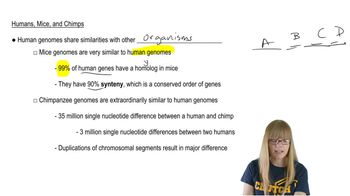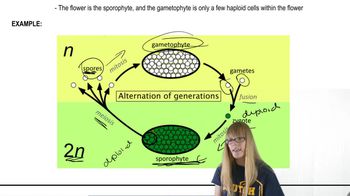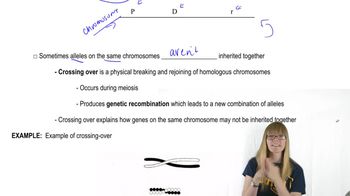Table of contents
- 1. Introduction to Genetics51m
- 2. Mendel's Laws of Inheritance3h 37m
- 3. Extensions to Mendelian Inheritance2h 41m
- 4. Genetic Mapping and Linkage2h 28m
- 5. Genetics of Bacteria and Viruses1h 21m
- 6. Chromosomal Variation1h 48m
- 7. DNA and Chromosome Structure56m
- 8. DNA Replication1h 10m
- 9. Mitosis and Meiosis1h 34m
- 10. Transcription1h 0m
- 11. Translation58m
- 12. Gene Regulation in Prokaryotes1h 19m
- 13. Gene Regulation in Eukaryotes44m
- 14. Genetic Control of Development44m
- 15. Genomes and Genomics1h 50m
- 16. Transposable Elements47m
- 17. Mutation, Repair, and Recombination1h 6m
- 18. Molecular Genetic Tools19m
- 19. Cancer Genetics29m
- 20. Quantitative Genetics1h 26m
- 21. Population Genetics50m
- 22. Evolutionary Genetics29m
4. Genetic Mapping and Linkage
Mapping Overview
Problem 2a
Textbook Question
In a diploid species of plant, the genes for plant height and fruit shape are syntenic and separated by 18 m.u. Allele D produces tall plants and is dominant to d for short plants, and allele R produces round fruit and is dominant to r for oval fruit. A plant with the genotype DR/dr produces gametes. Identify gamete genotypes, label parental and recombinant gametes, and give the frequency of each gamete genotype.
 Verified step by step guidance
Verified step by step guidance1
Identify the parental gametes based on the given genotype DR/dr. The parental gametes are DR and dr.
Determine the recombinant gametes. Since the genes are syntenic and separated by 18 map units, the recombinant gametes are Dr and dR.
Calculate the frequency of recombinant gametes. Since 1 map unit corresponds to 1% recombination frequency, 18 map units correspond to 18% recombination frequency. Therefore, the frequency of each recombinant gamete (Dr and dR) is 9%.
Calculate the frequency of parental gametes. Since the total recombination frequency is 18%, the remaining 82% is for parental gametes. Therefore, the frequency of each parental gamete (DR and dr) is 41%.
Summarize the gamete genotypes and their frequencies: Parental gametes DR and dr each have a frequency of 41%, while recombinant gametes Dr and dR each have a frequency of 9%.
Recommended similar problem, with video answer:
 Verified Solution
Verified SolutionThis video solution was recommended by our tutors as helpful for the problem above
Video duration:
2mPlay a video:
Was this helpful?
Key Concepts
Here are the essential concepts you must grasp in order to answer the question correctly.
Synteny
Synteny refers to the conservation of gene order on chromosomes between different species or within the same species. In this context, the genes for plant height and fruit shape are located on the same chromosome, which affects how they are inherited together. Understanding synteny is crucial for predicting gamete formation and the inheritance patterns of linked traits.
Recommended video:
Guided course

Humans, Mice, and Chimps
Gamete Formation and Recombinant Types
Gamete formation involves the segregation of alleles during meiosis, leading to the production of haploid cells. In this scenario, the parental gametes are those that carry the original combinations of alleles (DR and dr), while recombinant gametes arise from crossing over and carry new combinations (Dr and dR). Identifying these types is essential for calculating their frequencies and understanding genetic variation.
Recommended video:
Guided course

Formation of Plant Gametes
Map Units and Genetic Linkage
Map units (m.u.) are a measure of genetic distance that reflects the frequency of recombination between genes on a chromosome. An 18 m.u. distance indicates that 18% of the gametes will be recombinant due to crossing over. This concept is vital for determining the expected frequencies of each gamete genotype and understanding the strength of linkage between the traits in question.
Recommended video:
Guided course

Mapping Overview

 11:11m
11:11mWatch next
Master Mapping Overview with a bite sized video explanation from Kylia Goodner
Start learningRelated Videos
Related Practice

